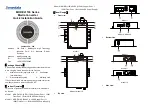
30
where:
d is the deviation in %
Vt is the top string voltage
Vb is the bottom string voltage
V is the voltage of the battery (V = Vt + Vb)
9.3 Setting the alarm level
In case of VRLA (gel or AGM) batteries, gassing due to overcharging will dry out the electrolyte, increasing
internal resistance and ultimately resulting in irreversible damage. Flat plate VRLA batteries start to lose water
when the charge voltage approaches 15V (12V battery). Including a safety margin, the midpoint deviation should
therefore remain below 2% during charging. When, for example, charging a 24V battery bank at 28.8V absorption
voltage, a midpoint deviation of 2% would result in:
𝑉𝑉𝑡𝑡
=
𝑉𝑉
×
𝑑𝑑
100 +
𝑉𝑉𝑏𝑏
=
𝑉𝑉
×
𝑑𝑑
100 +
𝑉𝑉 − 𝑉𝑉𝑡𝑡
=
𝑉𝑉
×
1 +
𝑑𝑑
100
2
Therefore:
𝑉𝑉𝑡𝑡
=
𝑉𝑉
×
1 +
𝑑𝑑
100
2
𝐷𝐷𝑛𝑛𝑑𝑑
𝑉𝑉𝑏𝑏
=
𝑉𝑉
×
1
− 𝑑𝑑
100
2
𝑉𝑉𝑡𝑡
= 28.8 ×
1 + 2
100
2
≈
14.7
𝐷𝐷𝑛𝑛𝑑𝑑
𝑉𝑉𝑏𝑏
= 28.8 ×
1
−
2
100
2
≈
14.1
Obviously, a midpoint deviation of more than 2% will result in overcharging the top battery and undercharging the
bottom battery. These are two good reasons to set the midpoint alarm level at not more than d = 2%.
This same percentage can be applied to a 12V battery bank with a 6V midpoint.
In case of a 48V battery bank consisting of 12V series connected batteries, the % influence of one battery on the
midpoint is reduced by half. The midpoint alarm level can therefore be set at a lower level.
9.4 Alarm delay
In order to prevent the occurrence of alarms due to short term deviations that will not damage a battery, the
deviation must exceed the set value during 5 minutes before the alarm is triggered. A deviation exceeding the set
value by a factor of two or more will trigger the alarm after 10 seconds.
9.5 What to do in case of an alarm during charging
In case of a new battery bank
The alarm is usually due to differences in the initial state of charge of the individual battery. If the deviation
increases to more than 3% you should stop charging the battery bank and charge the individual batteries or cells
separately. Another way is to substantially reduce the charge current to the battery bank, this will allow the
batteries to equalize over time.
If the problem persists after several charge-discharge cycles do the following:
•
In case of series-parallel connection disconnect the midpoint, parallel connection wiring and measure the
individual midpoint voltages during absorption charging to isolate batteries or cells which need additional
charging.
•
Charge and then test all batteries or cells individually.
Battery bank voltage
DC
Loads
Midpoint
Top string voltage
Bottom string voltage







































